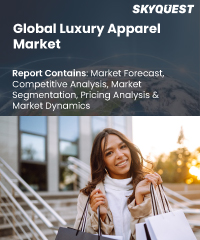
Product ID: SQMIG25K2085

Report ID:
SQMIG25K2085 |
Region:
Global |
Published Date: February, 2024
Pages:
203
|
Tables:
121 |
Figures:
79
Luxury Apparel Market size was valued at USD 6.13 billion in 2019 and is poised to grow from USD 7.88 billion in 2023 to USD 12.27 billion by 2031, growing at a CAGR of 8.05% in the forecast period (2024-2031).
The increased number of millionaires and client brand loyalty are expected to fuel growth. The expanding consumer notion that luxury items lead to higher social acceptance is boosting product demand. Rising disposable income and consumer expenditure on high-end goods are also important drivers boosting demand.
Many first-time consumers of luxury clothing do so to experience high quality and to project a certain image in society. Most of the time, this results in brand loyalty, and as a result, they are willing to pay a little more money to buy from their preferred businesses. Recognized luxury brands maintain consistency in product quality and pay close attention to consumer perceptions. This helps to shape the evolution of brand names. The public's word-of-mouth conversation is very important in promoting luxury apparel. Luxury apparel's higher price range and style quotient are some of its USPs, but the simple availability of copy products of top brands at lower rates is one of the luxury apparel market's significant limitations. Consumers' lack of information about the authenticity of these products causes them to purchase counterfeit goods, harming their brand loyalty.
Our industry expert will work with you to provide you with customized data in a short amount of time.
REQUEST FREE CUSTOMIZATIONLuxury Apparel Market size was valued at USD 6.13 billion in 2019 and is poised to grow from USD 7.88 billion in 2023 to USD 12.27 billion by 2031, growing at a CAGR of 8.05% in the forecast period (2024-2031).
Want to customize this report? This report can be personalized according to your needs. Our analysts and industry experts will work directly with you to understand your requirements and provide you with customized data in a short amount of time. We offer $1000 worth of FREE customization at the time of purchase.

Product ID: SQMIG25K2085